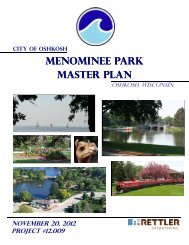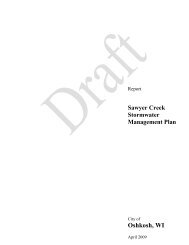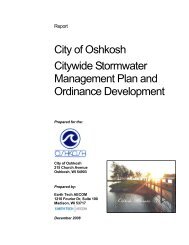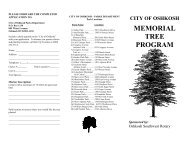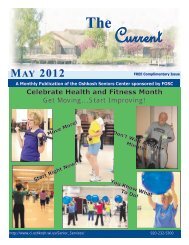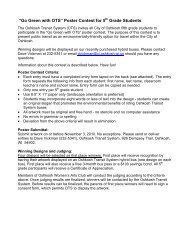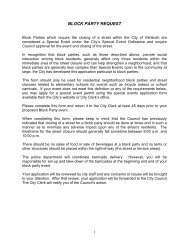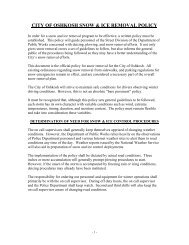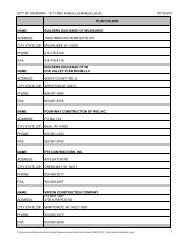City of Oshkosh, Wisconsin Pedestrian and Bicycle Circulation Plan
City of Oshkosh, Wisconsin Pedestrian and Bicycle Circulation Plan
City of Oshkosh, Wisconsin Pedestrian and Bicycle Circulation Plan
You also want an ePaper? Increase the reach of your titles
YUMPU automatically turns print PDFs into web optimized ePapers that Google loves.
Origins <strong>and</strong> Destinations<br />
Generally, motorized <strong>and</strong> non-motorized transportation users share similar origins <strong>and</strong><br />
destinations - but use different modes to accomplish their goal <strong>of</strong> arriving at a destination<br />
safely <strong>and</strong> efficiently. Arterial <strong>and</strong> collector roads that effectively deliver many motorists<br />
also provide the most direct <strong>and</strong> continuous routes for many bicyclists. These systems,<br />
however, are not always designed to accommodate the special needs <strong>of</strong> the average<br />
bicyclist. When roadway conditions are unsuitable for bicyclists, infrastructure design<br />
treatments may be used to improve the roadway or an alternative corridor may be<br />
selected. To reduce the potential <strong>of</strong> bicycle–vehicle conflicts where possible, the<br />
Stakeholder/Steering Group chose to use alternate street networks for the bicycle facility<br />
routes to improve overall safety <strong>and</strong> comfort <strong>of</strong> riders.<br />
Potential use patterns are not always reflected by the existing transportation system, but<br />
can be estimated by locating trip generators (origins <strong>and</strong> destinations) <strong>and</strong> projecting<br />
areas <strong>of</strong> population growth <strong>and</strong> future l<strong>and</strong> use patterns.<br />
Generally speaking, people are less willing to commute to work by bicycling <strong>and</strong><br />
walking if the travel time is more than 20 minutes. Directness <strong>of</strong> the route, physical<br />
condition <strong>of</strong> the bicyclist, number <strong>of</strong> stops <strong>and</strong> availability <strong>and</strong> proximity <strong>of</strong> bicycle<br />
parking facilities will affect how far one is able to cycle in 20 minutes. The average<br />
adult cyclist commonly travels 3 to 4 miles in 20 minutes. From a bicyclist's st<strong>and</strong>point, this<br />
3-4 mile trip defines the service area <strong>of</strong> each destination <strong>and</strong> helps to define commuting<br />
use patterns. Recreational riders will ride much farther in a day - trips <strong>of</strong> 30 to 40 miles<br />
are not unusual <strong>and</strong> tours <strong>of</strong> 80 to 100 miles are <strong>of</strong>fered regularly during the biking<br />
season in <strong>Wisconsin</strong>. Fitness riders <strong>and</strong> bike racers will travel 30 to 50 miles in a typical<br />
training ride.<br />
At the regional level, other communities <strong>and</strong> major recreational destinations are the prime<br />
trip generators. Within the urban <strong>and</strong> suburban areas, these destinations also include<br />
local shopping, employment, <strong>and</strong> government centers.<br />
4.1.4 TRANSIT INTERFACE<br />
The <strong>City</strong> <strong>of</strong> <strong>Oshkosh</strong> Transportation Department provides public transportation<br />
services in the <strong>Oshkosh</strong> area. Owned by the <strong>City</strong> <strong>of</strong> <strong>Oshkosh</strong>, limited service is<br />
also provided to the <strong>City</strong> <strong>of</strong> Neenah. Most transit users access the bus system on<br />
foot <strong>and</strong> rely on pedestrian facilities. Inadequate pedestrian facilities not only<br />
make it more difficult to use the bus, they can also pose safety hazards to riders.<br />
Increasing the number <strong>of</strong> shelters or street furniture for pedestrians waiting for<br />
buses may improve comfort levels for transit users. Transit users who access the<br />
bus system via bike must rely on the availability <strong>of</strong> an adequate location to lock<br />
their bike once arriving at the bus stop, or must bring their bicycle with them.<br />
<strong>Oshkosh</strong> has recently started retr<strong>of</strong>itting buses with front-end bicycle racks so users<br />
can transport their bicycles to their destination.<br />
4.2 COMMUNITY AND USER CHARACTERISTICS<br />
This section includes Census 2000 data related to walking <strong>and</strong> biking in the <strong>Oshkosh</strong><br />
area. It should be noted that most <strong>of</strong> this data is derived from the “long-form” which was<br />
r<strong>and</strong>omly distributed to 1 in 6 households <strong>and</strong> while this should not skew results, the time<br />
<strong>of</strong> enumeration may have an impact. The Census is recorded in March making conditions<br />
in north central <strong>Wisconsin</strong> less than ideal for biking <strong>and</strong> walking. The data should be<br />
used to establish a baseline <strong>of</strong> users in the planning area, to compare to other<br />
communities, <strong>and</strong> to reserve for evaluation against the next Census (2010).<br />
CITY OF OSHKOSH BICYCLE AND PEDESTRIAN PLAN 4- 3



